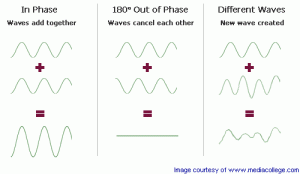ACINONYX
Bass Pickups & Preamps
Guitar Pickups & Pedals
Accessories & Swag
Tech Tips: Phase, Let’s Work Together
January 06, 2015 3 min read

It can be a frustrating experience when installing new pickups to find out that your brand new Jazz Bass bridge pickup has now made your bass sound distant and tinny. That’s a sure sign that you have phase issues.
What do people mean when they reference the phase of a pickup? In phase and out of phase sound very different, but what exactly does that mean? Being mindful of phase is important when swapping pickups.
Phase is defined as the timing and direction of the swing of the soundwave. This is usually pertaining to conversations including at least 2 coils. A single coil cannot be out of phase with itself. Think of a horse pulling a cart. If two horses are pulling a cart in two different directions, The cart will not move in either direction. The cart will move, but not where it should. If they both pull in the same direction, the cart follows. So you have to get your horses in order to get moving.
Now if your pickups are out of phase, you will lose volume on the fundamental note. The harmonics are slightly different from each other on any point of the string, so you will hear them more because they aren’t cancelling out like the fundamental does. On a pure sine wave, like a synthesizer note, you can cancel out the sound entirely. This is how noise cancelling headphones work.
 Here is a diagram that better describes phase.
Here is a diagram that better describes phase. You will see that when the waves line up, more signal gets sent to the amp. When these waves work against each other, less signal gets sent.
Most manufacturers have a consistent and predictable phase direction in their products, but not always. For example, some years of Fender MIM Jazz Basses use identical pickups in the neck and bridge positions with just the positive and negative leads reversed. Some don’t. Fender has a positive phase, while G&L (also Leo Fender designs) often have a negative phase. This can make it hard to achieve the correct phase when wiring up a new pickup.
To get your pickups working together, you need to be aware of their individual polarities. The goal when using two pickups together is usually to phase cancel the interference while not cancelling out the note played. There is any easy way to test for polarity with a voltmeter and small piece of ferrous (anything that sticks to a magnet) metal. Connect the probes from from the voltmeter to the output from the pickup minding the positive and negative leads. Bring the metal close to and touch any polepiece gently. If the voltage reads higher when bringing the metal in and lower when the metal is pulled away, that pickup has a positive polarity. The reverse is true for negative polarity. If one pickup has a positive polarity and the other a negative, you need to switch the positive and negative leads for one pickup for them to be in phase with each other. It doesn’t matter which one. As long as both pickups are the same polarity, they will sound in phase.
Some artists like Peter Green use an out of phase sound on purpose and it definitely has it’s place in some situations. The best way to figure out what you like is to experiment.
Be aggressively experimental!
Email john@nordstrandpickups.com with questions or suggested topics to cover.
Also in News
About The Blog
Our blog features conversations with Nordstrand Artists, new product release information, interviews and more. If there is a topic that you'd like to read about, please drop us a line.
Categories
- Alnico V
- Bass Pickups
- Big Single
- Big Singles
- custom pickups
- Endorser
- Endorser Profile
- ERB
- extended range bass
- Fat Stacks
- Guitar Pickups
- Johnny Gomez
- Moba Jones
- NAMM
- neck pickup
- New Music
- New Products
- Nordenbocker
- Nordstrand Basses
- nordstrand pickups
- Nordstrand Team
- nvs
- nvt
- Out of the Shop
- piccolo
- Rickenbacker
- Shop Visits
- stew mckinsey
- stratocaster
- Tech Tips
- telecaster
- Trade Shows
Recent Articles
- Jeff Matz
- Acinonyx Short Scale Bass - Coming Soon!
- In the Workshop: The Birth of Acinonyx
- Notes from the Road: BigRig 6
- Demo Day 2018
- Nordstrand Audio releases the Nordenbocker: Big Single neck pickup
- Find Nordstrand @ NAMM
- #NordstrandNovember Sweeps is here!
- Carey chats with... Johnny Gomez
- Frets for Vets
Subscribe to Nordstrand News
Sign up to get the latest on new releases, artists and more …





